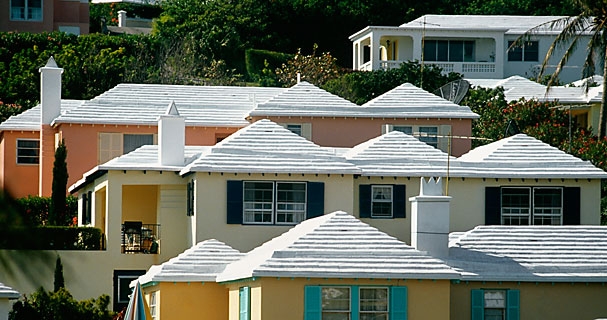forum
library
tutorial
contact

Study: White Rooftops
Could Curb Climate Change
by Eoin O'CarrollChristian Science Monitor, September 10, 2008
|
the film forum library tutorial contact |

|
Study: White Rooftops
by Eoin O'Carroll |
 If the world's 100 biggest cities were to whiten the roofs of all of their buildings and use more reflective pavement, the global cooling effect would be huge, a new study has concluded.
If the world's 100 biggest cities were to whiten the roofs of all of their buildings and use more reflective pavement, the global cooling effect would be huge, a new study has concluded.
Speaking at the Fifth Annual California Climate Change Research Conference in Sacramento, Hashem Akbari, a physicist with the Lawrence Berkeley National Laboratory, said that he has created a formula to determine how much heat-trapping carbon dioxide would be offset by reflecting the solar radiation back into space. In his presentation [PDF], he said that replacing the dark shingles on a 1,000-square-foot roof - the average size of an American home - with white material would offset 10 metric tons of greenhouse gases.
His paper, "Global Cooling: Increasing Worldwide Urban Albedos to Offset CO2," will be published in the journal Climatic Change.
While this may sound like greenwashing (but with whitewash), the potential savings here are huge. The LA Times walks us through the numbers:
Globally, roofs account for 25% of the surface of most cities, and pavement accounts for about 35%. If all were switched to reflective material in 100 major urban areas, it would offset 44 metric gigatons of greenhouse gases, which have been trapping heat in the atmosphere and altering the climate on a potentially dangerous scale.The benefits of white roofs and reflective pavement extend beyond climate change. White roofs can cut air conditioning costs by 20 percent, according to California's Energy Commissioner. And reflective surfaces would reduce what's known as the urban heat island effect, that is, the capacity of metropolitan areas to absorb more heat than their surrounding areas. According to Mr. Akbari's study, cooler temperatures would slow the rates of chemical reactions that produce smog.That is more than all the countries on Earth emit in a single year. And, with global climate negotiators focused on limiting a rapid increase in emissions, installing cool roofs and pavements would offset more than 10 years of emissions growth, even without slashing industrial pollution.
It sounds like a foolproof plan, but Keith Johnson, the Wall Street Journal's eco-blogger, is skeptical that we could pull it off:
Like with most grand plans, the devil is in the details. In many places, local zoning regulations strictly dictate architectural styles, including roof colors. Where white roofs are allowed or even required, progress comes piecemeal. Since 2005, California's had a building code that mandated white roofs for commercial buildings, and is currently beefing that code up to include other kind of roofs.Still, this doesn't have to be an all-or-nothing proposition. If Akbari's numbers are right, then converting 10 percent of the roads and rooftops of the world's 100 largest cities would offset one year of emissions growth. Not too shabby.But even the Golden State's environmental enthusiasm has limits-it can't make black-topped roads white overnight. The scale and cost of any program that would re-top all the roofs and paved surfaces in cities the size of Los Angeles, Mexico City, New Delhi, and Tokyo simultaneously makes Al Gore's plan to power America with 100% renewable energy in ten years seem cheap and doable by comparison.
That said, I'm not thrilled about the prospect of driving - or crossing a busy street - on a reflective surface. And not all of us get to live in sunny California. Sure, a white rooftop may cut my air-conditioning costs in the summer, but when winter comes, what will it do to my heating bill?
From Why the 2008 FCRPS Biological Opinion Does Not Include Removal of the Four Lower Snake River Dams by NOAA Fisheries, FCRPS Biological Opinion, 5/5/8The lower Snake River dams generate 1,022 average megawatts of emissions-free electricity per year, enough to power the city of Seattle. According to a 2007 study conducted by the Northwest Power and Conservation Council (NPCC 2007), removing the dams and replacing the power with the most likely fossil-fuel resource, would add 5.4 million tons of carbon dioxide (NPCC 2007 actually reported 4.4 million tons) every year to the region's air, contributing to the atmospheric carbon dioxide burden and possibly influencing climate change. The Council concluded that meeting the region's carbon reduction goals will be very challenging and that removing the lower Snake River dams would be "counterproductive."
NPCC 2007 states "Replacement of the power lost by breaching the lower Snake River dams by increased acquisition of conservation and renewable energy could, at least in the near term, delay some of the CO2 impacts of dam breaching. However, tying the increased development of conservation and renewables to dam breaching is misleading. If additional conservation and renewables are available and desirable, they should be pursued as part of a regional strategy to reduce CO2 emissions."
bluefish does the math: From Los Angeles Times article, "a 1,000-square-foot roof - the average size on an American home - offsets 10 metric tons of planet-heating carbon dioxide emissions in the atmosphere if dark-colored shingles or coatings are replaced with white material."
Fossil-fuel replacement of 4 Lower Snake River dams would add 4.4 million tons CO2/year.
393,000 average sized American homes converted to white roofs would offset 4.4 million tons of C02.
learn more on topics covered in the film
see the video
read the script
learn the songs
discussion forum
